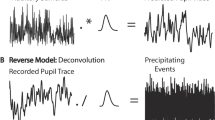Abstract
In order to gain an insight into the dynamics of the cardiovascular system throughout which the blood circulates, the signals measured from peripheral blood flow in humans were analyzed by calculating the Lyapunov exponents. Over a wide range of algorithm parameters, paired values of both the global and the local Lyapunov exponents were obtained, and at least one exponent equaled zero within the calculation error. This may be an indication of the deterministic nature and finite number of degrees of freedom of the cardiovascular system governing the blood-flow dynamics on a time scale of minutes. A difference was observed in the Lyapunov dimension of controls and athletes.
Similar content being viewed by others
References
Abarbanel, H. D. I., R. Brown and M. B. Kennel (1991). Variation of Lyapunov exponent on a strange attractor. J. Nonlinear Sci. 1, 175–199.
Abarbanel, H. D. I., R. Brown, J. J. Sidorowich and L. Sh. Tsimring (1993). The analysis of observed chaotic data in physical systems. Rev. Mod. Phys. 65, 1331–1392.
Akselrod, S., D. Gordon, F. A. Ubel, D. C. Shannon, A. C. Barger and R. J. Choen (1981). Power spectrum analysis of heart rate fluctuation: A quantitative probe of beat-to-beat cardiovascular control. Science 213, 220–222.
Bračič, M. and A. Stefanovska (1997). Local and global Lyapunov exponents of blood flow. Open Sys. & Information Dyn. 4, 435–456.
Bračič, M. and A. Stefanovska. Wavelet analysis in studying the dynamics of blood circulation. Open Sys. & Information Dyn. (in press)
Brown, R., P. Bryant and H. D. I. Abarbanel (1991). Computing the Lyapunov spectrum of a dynamical system from an observed time series. Phys. Rev. A43, 2787–2806.
Di Renzo, M., G. Mancia, G. Parati, A. Pedotti and A. Zanchetti (Eds) (1995). Computer Analysis of Cardiovascular Signals. Amsterdam, IOS Press.
Eckmann, J.-P. and D. Ruelle (1985). Ergodic theory of chaos and strange attractors. Rev. Mod. Phys. 57, 617–656.
Eckmann, J.-P. and D. Ruelle (1992). Fundamental limitations for estimating dimensions and Lyapunov exponents in dynamical systems. Physica D56, 185–187.
Fell, J. and P. Beckmann (1994). Resonance-like phenomena in Lyapunov calculations from data reconstructed by time-delay method. Phys. Rev. Lett. A190, 172–176.
Fell, J., J. Roschke and P. Beckmann (1993). Deterministic chaos and the first positive Lyapunov exponent: a nonlinear analysis of the humam electroencephalogram during sleep. Biol. Cyber. 69, 139–146.
Glass, L. and D. Kaplan (1993) Time series analysis of complex dynamics in physiology and medicine. Medical Progress through Technology 19, 115–128.
Goldhirsch, I., P. L. Sulem and S. A. Orszag (1987). Stability and Lyapunov stability of dynamical systems: a differential approach and a numerical method. Physica D27, 311–337.
Griffith, T. M. (1996). Temporal chaos in the microcirculation. Cardiovascular Research 31, 342–358.
Hoffmann, U., A. Yanar, U. K. Franzeck, J. M. Edwards and A. Bollinger (1990). The frequency histogram—a new method for the evaluation of laser Doppler flux motion. Microvascular Research 40, 293–301.
Holzfuss, J. and U. Parlitz (1990) Lyapunov exponents from time series. Lecture Notes in Mathematics 1486, 263–270.
Hyndman, B. W., R. I. Kitney and B. McA Sayers (1971). Spontaneous rhythms in physiological control systems. Nature 233, 339–341.
Kaplan, J. L. and J. A. Yorke (1978). Numerical solution of a generalized eigenvalue problem for even mappings. Lecture Notes in Mathematics 730, 228–237.
Kvernmo, H. D. and B. Østerud (1997). The effect of physical conditioning suggests adaptation in procagulant and fibrinolytic potential. Thromb. Res. 87, 559–569.
Lyapunov, A. M. (1892). General problem of stability of motion. Comm. Soc. Math. Kharkov 2, 265–272.
Mane, R. (1981). On the dimension of the compact invariant sets of certain nonlinear maps. Lecture Notes in Mathematics 898, 230–242.
Nilsson, G. E., T. Tenland and P. A. Öberg (1980). Evaluation of a laser Doppler flowmeter for measurement of tissue blood flow. IEEE Trans. Biomed. Eng. 27, 597–604.
Oseledec, V. I. (1968). A multiplicative ergodic theorem. Trans. Moscow Math. Soc. 19, 197–231.
Packard, N., J. Crutchfiels, D. Farmer and R. Shaw (1980). Geometry from time series. Phys. Rev. Lett. 45, 712–716.
Parlitz, U. (1992) Identification of true and spurious exponents from time series. Int. J. Bif. Chaos 2, 155–165.
Rosenstein, M. T., J. J. Collins and C. J. DeLuca (1993). A practical method for calculating the largest Lyapunov exponent from small data sets. Physica, D65, 117–134.
Rosenstein, M. T., J. J. Collins and C. J. DeLuca (1994). Reconstruction expansion as a geometry-based framework for choosing proper delay times. Physica, D73, 82–98.
Sano M. and Y. Sawada (1985). Measurement of the Lyapunov spectrum from a chaotic time series. Phys. Rev. Lett. 55, 1082–1085.
Sato, S., M. Sano and Y. Sawada (1987). Practical methods of measuring the generalised dimension and the largest Lyapunov exponent in high dimensional chaotic systems. Prog. Theor. Phys. 77, 1–5.
Stefanovska, A. (1992). Dissertation, University of Ljubljana, Ljubljana.
Stefanovska, A., P. Krošelj, M. Bračič and S. Strle (1997). Reconstructing cardiovascular dynamics. IFAC Meeting on Modelling and Control in Biomedical Systems, Warwick, UK, 23–26 March 1997.
Stern, M. D. (1975). In vivo observation of microcirculation by coherent light scattering. Nature 254, 56–58.
Takens, F. (1981). Detecting strange attractors in turbulence. Lecture Notes in Mathematics 898, 366–381.
Teichert, H. (1995). Asymptotic analysis of the Lyapunov exponents of certain linear Hamiltonian systems with small noise. Math. Nachr. 172, 291–311.
Wolf, A., J. B. Swift, H. Swinney and J. A. Vastano (1985). Determining Lyapunov exponents from time series. Physica D16, 285–317.
Author information
Authors and Affiliations
Corresponding author
Rights and permissions
About this article
Cite this article
Bračič, M., Stefanovska, A. Nonlinear dynamics of the blood flow studied by Lyapunov exponents. Bull. Math. Biol. 60, 417–433 (1998). https://doi.org/10.1006/bulm.1997.0007
Received:
Accepted:
Issue Date:
DOI: https://doi.org/10.1006/bulm.1997.0007




